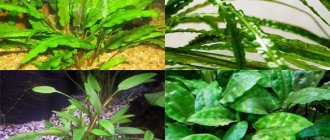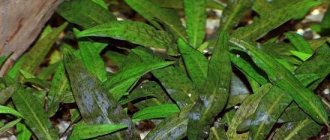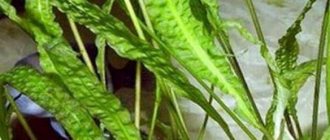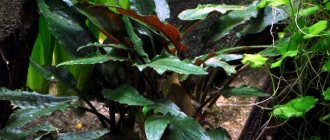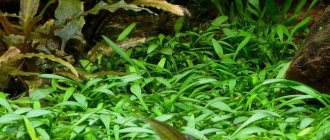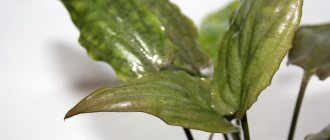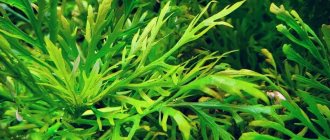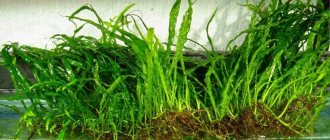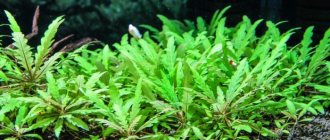Cryptocoryne Wendtii de Wit
) belongs to the araceae family (
Araceae
) and is the most common plant in home aquariums. In nature, it grows on the island of Sri Lanka in rivers and reservoirs with slow and fast currents. Appearance depends on the conditions of detention and type.
The leaves are large ovate or small lanceolate, can be either green or brown, and even red in bright light. Their length can reach 5-35 cm. The inflorescence has a complex shape and consists of an outer spathe and a spadix located inside. The blanket looks like a tube, slightly expanding at the bottom. Its purpose is to prevent water from reaching the cob.
Species of Cryptocoryne Wendt
Cryptocoryne wendta includes species of different sizes and colors:
- Mi oya.
- Green.
- Brown.
- Tropic.
- Green gecko.
- Flamingo.
- Florida sunset.
- Green jack.
- Broadleaf.
- Rubella.
- Beckett's petsch.
- Pontederifolia.
- Heart-shaped.
- Griffith.
- Minima.
- Yellow.
Mi oya
Cryptocoryne wendtii Mi Oya grows in the river Mi Oya of the same name. It has red-brown colored leaves. Grows up to 30 cm, suitable for large containers.
Green
Cryptocoryne wendtii Green is suitable for miniature aquariums due to its height of 10 cm. The foliage color of Cryptocoryne wendtii Green is bright light green.
Tropica
Cryptocoryne wendtii Tropica is a rosette bush 15 cm high. The leaves of Cryptocoryne wendtii Tropica are dark colored and have a hammered pattern.
Brown
Сryptocoryne wendtii Brown or cryptocoryne wendtii brown grows up to 25 cm and, due to its size, needs additional feeding. The foliage of Cryptocoryne wendta brown is bronze-brown.
View this post on Instagram
Posted by Terra Aquatica (@terraaquatica) Jul 14, 2021 at 8:47 am PDT
Green gecko
Cryptocoryne Wendtii Green Gecko lives on the island of Sri Lanka and reaches a size of 15 cm.
Flamingo
The Flamingo variety is distinguished by its pinkish coloration of the stem and leaves. Brought out by breeders.
Florida sunset
A small plant whose distinctive feature is the color of its leaves. Most often, the leaf is half colored pale pink and the other half green, or the leaf is pink with splashes of green.
Green jack
The leaves are brownish-brown in color and edged with green.
broadleaf
It is considered the ancestor of all other varieties. The bush is small in size, 10 cm, and the leaf length reaches 20 cm. The leaves are green-brown.
Rubella
The bush grows up to 13 cm and is distinguished by shortened petioles. The foliage is dark brown on top and gray underneath.
Description of the plant
Cryptocoryne Wendt is a perennial ornamental herbaceous shrub with a long creeping rhizome and large ovate or small lanceolate leaves located on petioles. Depending on the type and conditions of detention, the color of the plant can vary from green to brown.
It has inflorescences of complex shape, consisting of an outer cover and a small cob located inside. The blanket resembles a tube, slightly widened at the bottom, with a special valve that does not allow water to pass to the cob.
Cryptocoryne Wendt belongs to the large family of aroid plants. Under suitable conditions, the bush can grow up to 35-40 cm in height, forming loose thickets in the aquarium.
Habitat in nature
Cryptocoryne wendta not only decorates the aquarium, but also brings invaluable benefits to its inhabitants.
The island of Sri Lanka is considered to be the birthplace of Cryptocoryne. Grows actively in the warm, humid climate of the tropics and subtropics. In nature, the unpretentious plant is found on land, in swampy areas and in natural bodies of water with running or standing water.
Cryptocoryne grows well in both sea and fresh water. It can be submerged in water or partially protrude above the surface.
Benefits for the aquarium
The variety of shapes and colors of leaves allows you to create unique underwater landscapes. Bushes are well suited for small fish as a reliable shelter from predators. Suitable long parts of the plant can serve as convenient spawning grounds for females laying eggs.
Maintenance and care
Cryptocoryne is distinguished by its endurance and rapid adaptation to new conditions, so caring for the plant is not difficult. To keep the bush healthy, it is enough to keep the aquarium clean and monitor the water parameters.
Aquarium volume
The height of the aquarium is about 50 cm, since the bush can reach 30 centimeters, and the area is selected depending on the number of bushes. The distance between plants is 8–10 cm. The bush feels comfortable in small and large aquariums.
Lighting
Artificial and sunlight are equally suitable. The lighting should not be too bright; it is better to create diffused light or light shadow.
For artificial light, incandescent and fluorescent lamps with a power of 0.5 W/l are used. Daylight hours are 9–11 hours.
Priming
The soil must contain silt. To achieve siltation of the bottom, add peat or clay to the water. When filling the substrate, make sure that the soil layer is at least 3 cm, but not higher than 6 cm.
For better growth of cryptocoryne, mix coarse sea sand with small pebbles or crushed stone in equal parts. In such soil, wendta develops and grows evenly.
If you plant cryptocoryne not in water, but on a dry piece of land, then the soil should contain peat and clay to maintain moisture.
Water parameters
Wendta is a tropical plant, such an environment means high temperatures. Therefore, maintain the water temperature at least 23 degrees. But do not raise the temperature above 30 degrees. Comfortable temperature is 24–27 degrees.
Any acidity is suitable, even alkaline and sour. But average values of 6–8 pH are preferable.
But Vendta is more demanding when it comes to water hardness. Water that is too soft is unsuitable and causes growth to slow down and leaves to fall off. Comfortable hardness levels are considered to be 8–15 dH.
Aeration
The plant does not need aeration too much, but if possible, install a medium-power compressor.
Filtration
Turbidity and particles in the water settle on the leaves and interfere with photosynthesis. To maintain cleanliness, purchase a powerful filter.
Top dressing
When keeping a bush together with fish, additional feeding is not required, because the remains of the fish’s vital activity sufficiently fertilize the soil. But even in a herbal garden without fish, the plant can do without fertilizers, but if possible, it is still better to feed the bush. Add a minimal amount of iron, copper, boron and other minerals to the water, and the plants will feel better and healthier.
Useful lifehacks
We bring to your attention some “working” tips. We hope that they will help in breeding this plant:
- It is important to regularly check the condition of the soil, since nutrients accumulate in it along with fish waste products. To do this, once a month you need to carry out the following cleansing manipulation. Place a drain hose with a glass tip into the soil and use it to suck out the water. This operation must be repeated until the water with the smell of hydrogen sulfide completely disappears. The most clogged areas, as a rule, are the feeding areas of aquarium animals.
- When dividing plants, inexperienced aquarists often cut off the rhizome along with the roots. This is a grave mistake, since it is in this place that the main supply of nutrients is contained. It would be more correct to twist the long roots in a spiral and place them in the ground.
Aquadesign
When decorating an aquarium, the plant is planted in the middle part or in the foreground. To prevent the plant from stretching, you will need bright lighting. In small tanks it is used as background greenery.
The leaves of the plant grow laterally and have a rosette growth pattern, so it is planted next to long plants to create contrast. Cryptocoryne also hides the lower part of tall plants, which often loses its leaves and becomes bare due to lack of light.
Benefits of growing
good for growing in aquariums because it is not damaged by various pests and fish. This is due to its bitter taste, which apparently does not attract other inhabitants to eat it.
In addition, the plant adapts well to various conditions and chemical properties of water. It is perfect for decorating any aquarium or terrarium, where it will feel great, even rising above the water.
Compatibility with other aquarium inhabitants
Compatible with most types. It is especially suitable for predatory fish, but herbivores can spoil and eat foliage.
Compatible:
- Guppy.
- Discus.
- Neons.
- Pecilia.
- Angelfish.
- Mollies.
- Scarlet barbs.
- Cichlids.
- Characinaceae.
- Catfish.
- Botsiya.
Weakly compatible:
- Herbivorous snails.
- Cichlazoma Severum.
- Akara turquoise.
- Cichlazoma Meeka.
- Sumatran barbs.
Where does Cryptocoryne live?
This amazingly beautiful plant can be found near swampy ponds, which are located in Southeast Asia. This is his natural habitat.
At the same time, Cryptocoryne Wendt Lutea, as well as other varieties of this plant, are bred in aquariums and greenhouses. However, it may look less attractive if you choose a greenhouse for their growing location. However, there is a plus to this - the plant will reach its maximum height faster and will definitely bloom.
Diseases and prevention
A common disease associated with this species is cryptocoryne disease. The causes are unknown; aquarists believe that the disease is caused by sudden changes in water, light, temperature or improper care. This is also how the plant can react to the ingress of chemical elements that are toxic to vegetation into the water. The disease develops rapidly, and tissue necrosis occurs within a day.
Signs of the disease: leaves soften and split, change color; holes appear due to tissue decomposition.
There are no specific patterns in its appearance, but most often plants get sick in winter. The disease is contagious and quickly spreads to other plants. Therefore, when a diseased plant is discovered, it needs to be dug up and transplanted into a quarantine tank.
There is no definite treatment, but if the disease has not progressed too much, then there is a chance to save the plant’s rhizome. To do this, remove the affected parts, change the water and remove dirt and remnants of old soil from the roots. Place the plants in a separate container.
To prevent the disease, follow the rules of maintenance, keep the water clean, do not raise the temperature above 30 degrees and beware of getting chemicals into the water.
Reproduction
Over time, small shoots appear on the root system of the mother plant. When these daughter shoots grow and a few leaves appear on them, the young plant can be separated and replanted in a layer of soil soaked in nutritional supplements. If shoots do not appear, reproduction occurs by dividing the rhizome. A small shoot of the root system is separated and planted in a separate container until shoots and leaves form. When the daughter shoot grows, it can be transplanted into a common aquarium.
Photo gallery
Valkera
Cryptocoryne walker is a small plant with beautifully colored variegated leaves. To avoid cryptocoryne disease, Cryptocoryne walker requires careful care. Cryptocoryne walker forms a dense carpet if aquarium conditions are favorable. Cryptocoryne walker has oval-shaped leaves with a sharp top and wavy edges. It develops well in fertilized soil; Cryptocoryne walker also responds positively to peat feeding. Cryptocoryne walker reproduces by layering with at least 5 leaves. Cryptocoryne walker is widely used to decorate the front and middle background of an aquarium.
Return to content
Balance
Cryptocoryne's balance sheet has a number of variations. Balance became famous for her capricious behavior and gentle beauty. If the basic requirements are met, cryptocoryne balance will reward the owner with lush greenery of emerald color. The leaves of the balance are lanceolate up to 50 cm, sometimes green and brown. Cryptocoryne balance has a horizontally located rhizome, on which there is a rosette of narrow leaves.
Balance is planted in a tall aquarium and grows up to 60 cm. Cryptocoryne balance is demanding of high-quality substrate.
Balance loves the bright diffused light of fluorescent lamps. Propagated by root layering with 4-5 leaves. The balance needs to be provided with aeration. To equip the roots with heating, you can install a bottom filter that draws water down.
Return to content
Reverse spiral
Cryptocoryne reverse spiral is common among more experienced aquarists and looks great in the background. Cryptocoryne reverse spiral is distinguished by narrow leaves and minimal tuberosity of the plates. The shades of the plant vary from dark green to pale olive. Cryptocoryne reverse spiral reaches 50 cm in height, so it is grown in large containers.
Return to content
Brilliant
Cryptocoryne splendor is a low-growing and inconspicuous species. Cryptocoryne brilliantis is exclusively green in color. The leaves are elongated and smooth, without tubercles. In the soil of small fractions, Cryptocoryne splendor takes root, forming new shoots, which gives dense, beautiful thickets. Cryptocoryne brillianti propagates easily, without leaves, you can transplant a shoot or a section of root to a new place.
Return to content
Related
Cryptocoryne related is a broadleaf variety that is very popular due to its beautifully colored striped leaves. Cryptocoryne related has tubercles on the leaf blade, and on the reverse side the leaves are red in color. Aquarium conditions require a temperature of 20-28°C; with frequent water changes or cleaning of the aquarium, the related Cryptocoryne often sheds its leaves. With a lack of lighting, the related Cryptocoryne loses its striping and purple color.
For good growth of Cryptocoryne, the related species requires the correct substrate; in poor soil, Cryptocoryne develops slowly and does not grow to large sizes. Cryptocoryne related reproduces in the aquarium vegetatively. In a humid greenhouse, the related cryptocoryne develops much better.
Return to content
Griffith
Cryptocoryne griffithis is a hybrid of the cordate Cryptocoryne. The color of the plant presents variations: shades of green and red-violet. Cryptocoryne griffith grows up to 35 cm, the optimal temperature is 25°C. The plant needs nutritious soil. Cryptocoryne griffithis is afraid of rot, regular water changes are recommended. One of the few species, Cryptocoryne griffithis loves bright light.
Return to content
Aponoghetonolifolia
Cryptocoryne aponoghetonolifolia is a beautiful giant compared to other species. Its oblong leaves can reach more than a meter in height. Cryptocoryne aponoghetonifolia is a very popular species, despite the difficulty of growing. The leaves of the plant are long with pointed ends, corrugated. Cryptocoryne aponoghetonolifolia grows slowly, one leaf in about 1 month. Cryptocoryne aponoghetonolifolia blooms beautifully with purple-brown tubes with a spiral-twisted end.
Return to content
Blassa
Cryptocoryne blasta is beautiful and decorative. Cryptocoryne blasta is a large plant that looks great in the background of a tropical aquarium. Shade-tolerant and does not require water changes. Cryptocoryne blasta can reach 50 cm in comfortable conditions. Cryptocoryne blassa grows very slowly, but evenly. Cryptocoryne blassa has a powerful root system from which petioles extend. Cryptocoryne blasta has different leaf colors: the top is light green with spots, the bottom is purple. Granite chips and small pebbles are suitable for the substrate; clay with charcoal and boiled peat can be placed on the bottom. Cryptocoryne blasta is the least fastidious representative of its genus.
Return to content
Pontederifolia
Cryptocoryne pontederiafolia - received its name due to its leaves, similar to the tropical plant pontederia. The leaves are heart-shaped green with an elongated tip. Cryptocoryne pontederifolia can tolerate temperatures as low as 18°C. Cryptocoryne pontederifolia can grow well in any light, but with prolonged shading the color fades, and excess light can lead to the plant becoming overgrown with algae. Cryptocoryne pontederifolia develops well in both fine and coarse soil and does not depend on fertilizing.
Return to content
